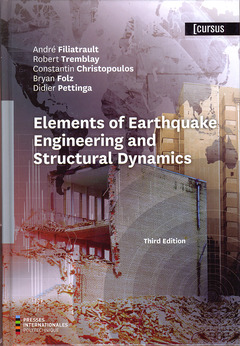Elements of earthquake engineering and structural dynamics (3rd Ed.) Cursus Series
Auteurs : FILIATRAULT André, TREMBLAY Robert, CHRISTOPOULOS Constantin, FOLZ Bryan, PETTINGA Didier

Preface
Biographical notes
CHAPTER 1 Preliminary Notions
Brief History of Earthquake Engineering. Development of Earthquake Engineering in the United States and Canada. Influence of Computers on the Development of Earthquake Engineering. Experimental Earthquake Engineering.
CHAPTER 2 Elements of Seismology and Seismicity
Causes of Earthquakes. Plate Tectonics and Reid’s Elastic Rebound Theories. Fault Mechanisms. Seismic Waves. Elastic Wave Model. Location of the Epicentre of an Earthquake. Modified Mercalli Intensity Scale and Richter Magnitude Scale. Evolution and Relationships Between Magnitude Scales. Ground Motion Characteristics Influencing Structural Response. Seismicity and Seismotectonics in the United States and Canada. Comparisons Between Eastern and Western North American Earthquakes. Attenuation Relations. Directivity Pulse Phenomenon and Near-Field Ground Motions.
CHAPTER 3 Elements of Seismic Hazard Analysis
Definition of Design Earthquake. Seismicity Model. Attenuation Models. Deterministic Seismic Hazard Analysis. Probabilistic Seismic Hazard Analysis. Seismic Hazard Maps for the United States and Canada. Seismic Hazard Curve Deaggregation.
CHAPTER 4 Elements of Structural Dynamic Analysis
Dynamic Analysis of Single-Degree-of-Freedom Structures. Response to Earthquake Loading. Simplified Design Response Spectra. Design Response Spectra. Floor Response Spectra. “Exact” Dynamic Analysis of Multi-Degree-of-Freedom Structures. Response Spectrum Analysis. Nonlinear Analysis of Multi-Degree-of-Freedom Structures. Types of Nonlinear Analysis.
CHAPTER 5 Elements of Soil Dynamics
Soil Dynamic Response. Determination of Physical Soil Properties. Lumped-Mass Dynamic Analysis of Horizontally Layered Soil Deposit on Rigid Bedrock. Steps and Illustration of Lumped-Mass Dynamic Analysis. Strength Loss and Soil Liquefaction. Soil-Structure Interaction.
CHAPTER 6 Elements of Seismic Design Procedures for Building Structures
Inelastic Seismic Response. Objectives and Principles of Ductile Earthquake-Resistant Design for Buildings. Overview of Building Code Requirements. Example of Building Seismic Analysis and Design.
CHAPTER 7 Elements of Seismic Design and Detailing for Steel Buildings
General Requirements. Steel Concentrically Braced Frames. Buckling Restrained Braced Frames. Eccentrically Braced Frames. Steel Moment-Resisting Frames.
CHAPTER 8 Elements of Seismic Design and Detailing for Reinforced-Concrete Buildings
Basic Philosophy of Reinforced Concrete Seismic Design. General Seismic Design Requirements of CSA in Canada and ACI in the United States. Design and Detailing Requirements for Ductile Seismic Lateral Resisting Systems.
CHAPTER 9 Elements of Seismic Design and Detailing for Light-Frame Wood Buildings
General Requirements. Shear Walls. Diaphragms. Design Examples According to CSA-086-09, 2012 NDS and 2008 SDPWS. Detailing to Ensure Load Transfer Continuity.
CHAPTER 10 Elements of Seismic Design for Nonstructural Building Components
Classification of Nonstructural Building Components. Seismic Performance of Nonstructural Components During the 2001 Nisqually Earthquake: A Case Study. Seismic Analysis of Nonstructural Components. Seismic Design of Nonstructural Components in the United States and Canada. Seismic Qualification Testing. 2012 International Code Council Evaluation Service. AC156 Acceptance Criteria. Nonstructural Component Simulator at the University at Buffalo.
CHAPTER 11 Overview of Supplemental Damping and Seismic Isolation Systems
Rain Flow Analogy. Energy Balance Formulation for a Single- Degree-of-Freedom Structural System. Supplemental Damping Systems. Seismic Response of Structures with Supplemental Damping of Seismic Isolation.
Answers to problems
References
Index
This book is intended for senior undergraduate and graduate structural engineering students, and university educators as well as practicing engineers who will all find it a valuable resource.
• Robert Tremblay, Eng., Ph.D., is a professor in the Department of Civil, Geological and Mining Engineering at École Polytechnique de Montréal, Canada.
• Constantin Christopoulos, Ph.D., P.Eng., is a professor in the Department of Civil Engineering at the University of Toronto, Canada.
• Bryan Folz, Ph.D., P.Eng., is a faculty member in the Department of Civil Engineering at the British Columbia Institute of Technology in Vancouver, Canada.
• Didier Pettinga, Ph.D., P.Eng., is a project engineer with Holmes Consulting Group in Christchurch, New Zealand.
Date de parution : 06-2013
Ouvrage de 854 p.
17.5x25.2 cm
